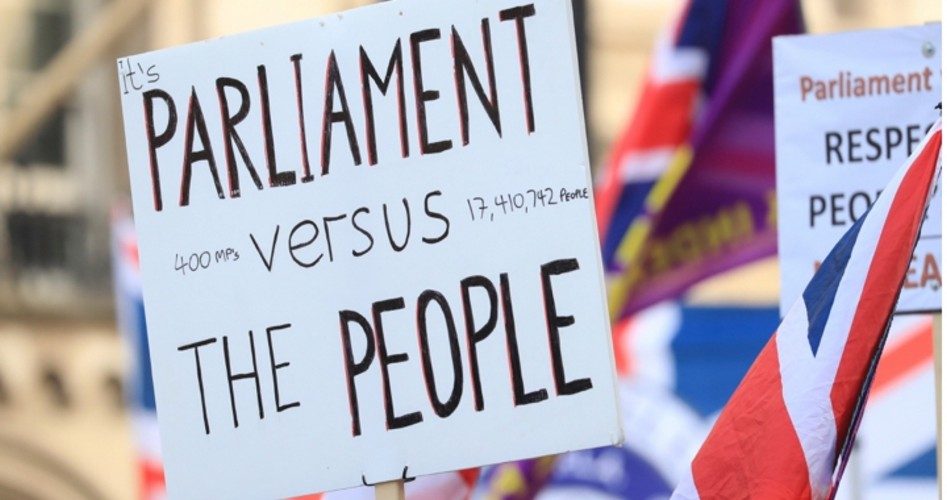
Today, March 29, was the day that the United Kingdom was originally scheduled to leave the European Union. That deadline has now been moved ahead to April 12. But that doesn’t mean that March 29 was not still a momentous day in British history. For this is the day that Great Britain found out that very few members of their government have any spine whatsoever.
Today, the House of Commons rejected Prime Minister Theresa May’s Brexit deal for a third time by a vote of 344 to 286. The vote has likely doomed May’s deal for good. Prospects going forward are that the UK either crashes out of the EU without a deal on April 12 or that a prolonged delay of Brexit ensues, which could last for an undefined amount of time.
May described the result of the vote as “grave.” She further said that “we are reaching the limits of this process in the House,” signaling that she might believe it is time to put Brexit’s future back into the hands of the voters given the parliamentary impasse.
“On Monday, this House will continue the process to see if there is a stable majority for a particular alternative version of our future relationship with the EU,” May told the House of Commons.
“The House has rejected no deal. It has rejected no Brexit. On Wednesday it rejected all the variations of the deal on the table. And today it has rejected approving the Withdrawal Agreement alone and continuing a process on the future.”
Donald Tusk, the President of the European Council, responded to events in the House of Commons by calling for an emergency meeting. “In view of the rejection of the Withdrawal Agreement by the House of Commons, I have decided to call a European Council on 10 April.”
Labour leader Jeremy Corbyn called for May’s immediate resignation in order to trigger a new general election. “On Monday, this House has the chance … the responsibility to find a majority for a better deal for all the people of this country,” Corbyn said.
May had already offered her party her resignation in exchange for a yes vote on her Withdrawal Plan. She told the powerful 1922 Committee of Conservative backbenchers, “I know some people are worried that if you vote for the withdrawal agreement, I will take that as a mandate to rush into phase two without the debate we need to have. I won’t — I hear what you are saying. But we need to get the deal through and deliver Brexit.”
“I am prepared to leave this job earlier than I intended in order to do what is right for our country and out party.”
But then the Democratic Unionist Party of Northern Ireland, a crucial part of May’s governing majority, crushed that idea by still refusing to back May’s plan because it “poses a threat to the integrity of the UK.”
MPs today also voted down eight separate indicative votes on alternatives to Prime Minister Theresa May’s Brexit plan. Tory MP Michael Fabricant tweeted an image of the indicative vote ballot.
The votes went like this:
1) Leave with no deal on April 12: Yes – 160; No – 400
2) Cancel Article 50: Yes – 184; No – 293
3) Hold a second Referendum: Yes – 268; No – 295
4) Permanent customs union with the EU: Yes – 264; No – 272
5) Norway style Brexit: Yes – 65; No – 377
6) The Labour Party’s Brexit plan: Yes – 237; No – 307
7) Malthouse Compromise: Yes – 139; No – 422
8) Common Market 2.0; Yes – 188; No – 283
The “leave with no deal” option is self-explanatory. The “cancel Article 50” option would trigger a vote on whether to cancel Brexit altogether if no deal can be agreed upon within two days of the new April 12 deadline. The “second referendum” option would require that any deal reached be put back to the public in a confirmatory vote. The “permanent customs union” option would require a permanent trade relationship with the EU and remove British sovereignty in trade issues.
The “Norway style” plan would not involve a customs arrangement with the EU but keep the UK in the European Economic Area, much like Norway currently is. The “Labour Party” plan includes a comprehensive trade agreement with the EU but with UK autonomy on future trade deals and continued participation in many EU programs. The “Malthouse Compromise” is a managed no-deal of sorts, requiring the UK to give the EU billions in exchange for a two-year “standstill” period. “Common Market 2.0” consists of continued membership in the EU customs union along with freedom of movement between the UK and EU, with the UK paying the EU for the privilege.
And if all of that sounds confusing to you, you’re not alone.
Again, these were “indicative” votes, in other words they were merely testing what PMs might support going forward. The second referendum option received the most votes, while a permanent customs union was the closest, with only an eight-vote majority voting no.
So, regardless of what happens going forward, Theresa May is likely out as prime minister within weeks — possibly even days. Several Tory MPs are said to be in the running to take over if May leaves, the most aggressive being former cabinet minister Boris Johnson, a hardline Brexiteer. Other expected to be in the running are Michael Gove, Jeremy Hunt and Sajid Javid.
Meanwhile, the EU is openly mocking British indecision on the issue. “If I were to compare Great Britain to a sphinx, the sphinx would be an open book by comparison,” said EU President Jean-Claude Juncker in a speech to the European Parliament today.
“And let’s see how that book speaks over the next week, or so.”
Given a simple directive by their citizens in 2016: Leave the European Union. Politicians have complicated and obfuscated the issue so much that it has become unrecognizable to anyone but themselves. With Theresa May’s abject failure on the Brexit issue, along with Parliament’s utter intransigence, the British ship of state appears both rudderless and leaderless.
Photo: AP Images




